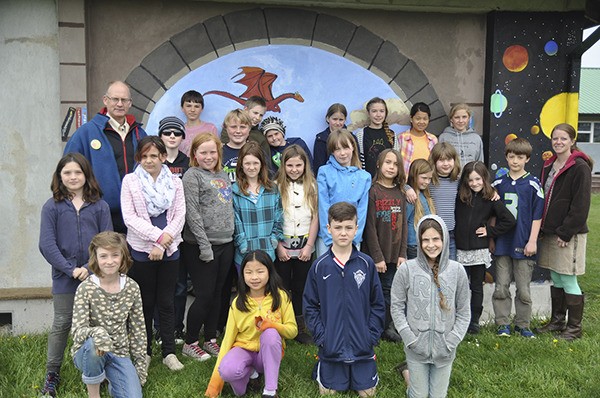After nearly a two-mile hike, water quality data analysis, exploring the beach and getting the hands-on experience of sifting through albatross boluses, the students from Five Acre School recently completed a field study with Feiro Marine Life Center.
It has been a few years since Five Acre participated in the North Olympic Watershed Science (NOW) program, but teachers at Five Acre School Tom Harris and Sarah Goff decided this year the program fit well with what their students were studying.
The study
With the creek’s health status at the forefront of their minds, 26 third- through seventh-grade students from Five Acre School determined the water quality of Peabody Creek.
The students were instructed to take water samples and record water quality data as they hiked downstream.
Based on their findings, the students concluded Peabody Creek is not a healthy creek, which may indicate the overall watershed isn’t as healthy as it could be.
Feiro Marine Life Center Director Deborah Moriarty explained how Peabody Creek lends itself nicely to the field study because students are able to begin in a wilderness setting inside the Olympic National Park and then hike downstream through various stages of urbanization until they reach downtown Port Angeles.
“Peabody Creek is a perfect place to conduct a field study because the students are able to begin their study in a pristine environment and observe the creek as it goes through and under the city,” Moriarty said. “In less than a two-mile walk kids can see and identify for themselves the impacts humans can have on the creek’s health.”
After hiking Peabody Creek the students participated in both a beach exercise at Hollywood Beach and a visit to the Olympic Coast Discovery Center where they pulled apart the contents of albatross boluses (the indigestible contents of large seabird chicks which must be vomited up before they’re able to take flight). The boluses are often packed with plastics and garbage that has been adrift in the Pacific Ocean.
The opportunity for students to deconstruct albatross boluses helped connect the serious impact trash and pollution can have, Goff explained.
“Learning about how much human impact the area takes was my least favorite part, but I think it was a great opportunity,” fifth-grade student Abby Schroeder said. “I think we could help by educating people not to litter.”
In addition to the students’ field trip to the Feiro Marine Life Center and Olympic Discovery Center, the program instructors from Feiro visited the students at their classroom with a large tabletop model of a hypothetical town. With this model students were able to restructure the town to reflect good water quality stewardship.
Students of all ages
Unlike other fourth- and fifth-grade classes involved with NOW, the students at Five Acre School stay together during the field study despite their varied grade levels.
“For the students to be able to share a common experience is a great thing and helps to unify us,” said Tom Harris, a teacher at Five Acre School.
Although there are times when it is needed to separate the students based on grade, for things like social time, with group projects and field trips the mix of ages and grades goes unnoticed, Harris explained.
This was Five Acre School’s fourth time participating in the NOW program, though it had been a few years since its last involvement.
Because of the school’s multi-grade structure Five Acre School staggers its participation with the program to avoid repetition for the students. “Having multiple grade levels in a single field study can work to the students’ advantages,” Goff said. “The younger students often learn from the older students by watching and listening to them.”
The take-away
Both Harris and Goff agree the NOW program offered a positive experience and enjoy watching the students bring the knowledge they gathered from the field study back to the classroom and apply it to their own projects.
“When deciding on field trips, we look for something that will align with what we’ve been studying,” Goff said. “Lately we’ve been studying tree planting.”
For example, Goff explained how among the many things the NOW program provided, it gave students the opportunity to observe the role trees play in stream bank stabilization in addition to the numerous influences trees have on a watershed.
The NOW program is funded by the National Oceanic and Atmospheric Administration (NOAA) and offered through the partnership of Nature Bridge, Olympic Coast National Marine Sanctuary and Feiro Marine Life Center. NOW is available to students from Sequim, Port Angeles and Crescent schools and includes both a classroom visit and field study to introduce students to watershed and marine-related issues.
“We want people to begin to understand how they affect the streams, rivers, lakes, watershed and ocean environments,” Moriarty said.
For more information about the NOW program or to contact the Feiro Marine Life Center, visit feiromarinelifecenter.org or call 417-6254.



